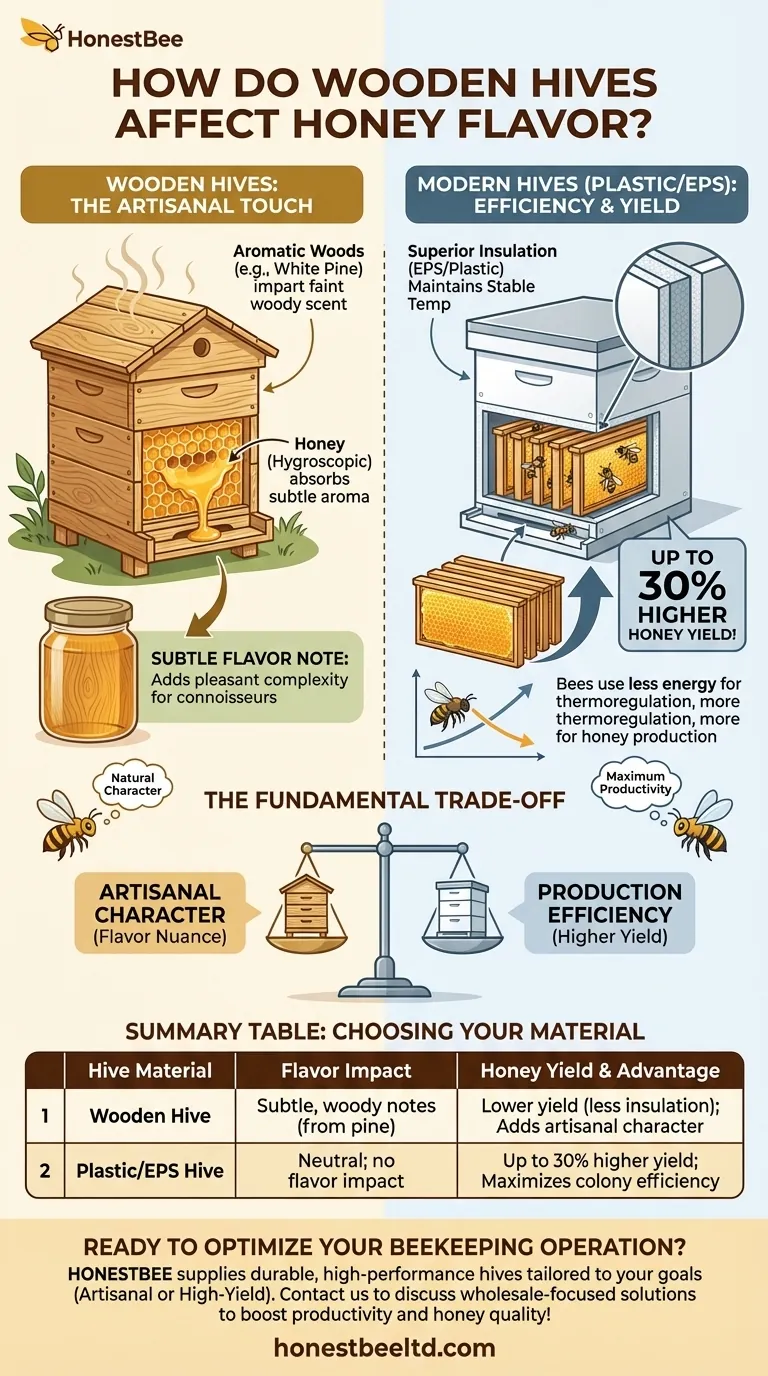Yes, wooden hives can influence the flavor of honey. Specifically, aromatic woods like white pine can impart a faint, woody scent and taste to the honey. This effect is subtle and often only detectable by honey connoisseurs, who may find it adds a pleasant complexity to the honey's profile.
The choice of hive material presents a fundamental trade-off. While wooden hives can introduce subtle, artisanal flavor notes into the honey, modern materials like plastic or polystyrene prioritize hive efficiency and can lead to significantly higher honey yields.

The Direct Impact of Wood on Honey Flavor
The Role of Aromatic Woods
Woods like white pine are naturally aromatic. They contain volatile compounds that create a distinct, fresh scent within the hive environment.
How Scent is Transferred
Honey is hygroscopic, meaning it readily absorbs moisture—and scents—from its immediate surroundings. The constant, close contact between the honey, the wax, and the air inside a wooden hive allows for this subtle transfer of aroma.
A Subtle, Connoisseur's Note
This infusion is not overpowering. It manifests as a slight woodiness in the taste and aroma. For many honey enthusiasts, this nuance is a desirable characteristic that complements the honey’s natural floral notes.
Beyond Flavor: Hive Material and Production Efficiency
While flavor is a key consideration, the material of the hive also has a profound impact on the bee colony's energy expenditure and, consequently, its honey production.
The Critical Role of Insulation
Bees must work constantly to maintain a stable internal hive temperature (around 95°F or 35°C) for brood-rearing. This process consumes a significant amount of energy, which the bees derive from eating their own honey stores.
The Efficiency of Modern Materials
Modern hives made from EPS (Expanded Polystyrene) or plastic offer superior insulation compared to wood. This thermal efficiency means the hive naturally stays warmer in the winter and cooler in the summer.
The Link to Honey Yield
Because bees in a well-insulated hive expend far less energy on temperature regulation, they can devote more energy to foraging and producing honey. Commercial beekeepers have reported that EPS hives can increase honey yield by as much as 30% for this reason.
Understanding the Trade-offs
Choosing a hive material is about balancing priorities. There is no single "best" option; the right choice depends entirely on your goals as a beekeeper.
Wood: Natural Character vs. Lower Efficiency
A wooden hive offers a traditional aesthetic and the potential to add a unique, desirable character to your honey. However, its comparatively poor insulation means the colony must work harder, which can result in lower overall honey yields.
Plastic/EPS: Higher Yield vs. Neutral Impact
Insulated hives are designed for maximum efficiency. They reduce stress on the colony and free up the bees' energy to focus on honey production, leading to larger harvests. The trade-off is that these inert materials will not impart any unique flavor notes to the final product.
Making the Right Choice for Your Goal
Your decision should be guided by what you value most in your beekeeping practice.
- If your primary focus is artisanal character and flavor nuance: A wooden hive, especially one made of pine, is the ideal choice to impart a subtle, unique terroir to your honey.
- If your primary focus is maximizing honey yield and colony productivity: An insulated hive made from high-density EPS or plastic will give your bees a significant efficiency advantage.
Ultimately, your choice of hive material is a decision that directly shapes both the unique character of your honey and the overall productivity of your bees.
Summary Table:
| Hive Material | Flavor Impact | Honey Yield | Primary Advantage |
|---|---|---|---|
| Wooden Hive | Imparts subtle, woody notes (e.g., from pine) | Lower yield due to less insulation | Adds artisanal character and complexity |
| Plastic/EPS Hive | Neutral; no flavor impact | Up to 30% higher yield from better insulation | Maximizes colony efficiency and productivity |
Ready to optimize your beekeeping operation? Whether you're a commercial apiary aiming for maximum yield or a distributor seeking reliable equipment, HONESTBEE supplies durable, high-performance beekeeping supplies and hives tailored to your goals. Contact us today to discuss how our wholesale-focused solutions can boost your productivity and honey quality!
Visual Guide

Related Products
- Langstroth Bee Hives Bee Keeping Box for Beginners Beekeeping
- Wholesales Dadant Size Wooden Bee Hives for Beekeeping
- HONESTBEE Professional Long Handled Hive Tool with Precision Cutting Blade
- HONESTBEE Advanced Ergonomic Stainless Steel Hive Tool for Beekeeping
- Professional Dual-End Stainless Steel Hive Tool for Beekeeping
People Also Ask
- How does the ease of access differ between 8-frame and 10-frame hives? Choose the Right Hive for Your Body
- Should a beginner try a different type of hive? Start with a Langstroth for a solid foundation.
- What are the key features of the Langstroth beehive? A Guide to the Standard for Modern Beekeeping
- Why are Langstroth hives recommended for beginners? Unmatched Support & Standardization
- What basic equipment is needed to start beekeeping? Your Essential Guide to a Confident Start



















